Evaluation of Differential Settlement of Subgrade for Highway-Widening Projects
Abstract
1. Introduction
2. Settlement Analysis Model Establishment and Verification
3. Establishment and Parameter Determination of Post-Construction Settlement Model
3.1. Parameter Determination
3.1.1. Typical Soil Parameters
3.1.2. Parameters of Foundation
3.1.3. Subgrade Parameters
3.2. Establishment of the Numerical Model
4. Results and Discussion
4.1. Influence of Groundwater Level on Subgrade Settlement
4.2. Influence of Subgrade Height on Settlement
4.3. Evaluation of Post-Construction Differential Settlement
4.3.1. Differential Settlement Coupling Analysis
4.3.2. Evaluation Index Δi
4.3.3. Evaluation Index k
5. Conclusions
- Part of the differential settlement of the new subgrade could be eliminated during the construction process, and the post-construction differential settlement of the subgrade accounts for about 70% of the total differential settlement;
- With the decrease in groundwater level, the differential settlement increases gradually during the construction period, whereas the post-construction differential settlement decreases slightly. For 4 m high subgrade, when the groundwater level decreases from −3 m to −11 m, the corresponding differential settlement during construction increases from 8.25 cm to 10.82 cm, and the post-construction differential settlement decreases by 11%;
- With the increase in subgrade height, the differential settlement increases gradually during and after construction. For a −5 m groundwater level, when the subgrade height increases from 2 m to 8 m, the corresponding differential settlement during construction increases from 5.86 cm to 13.88 cm, and the differential settlement after construction increases by 43%;
- The transverse slope of the road arch shall not rise by more than 0.5% on either the enlarged or existing subgrade. Taking the increased value (Δi) of the transverse slope of the road crown as the evaluation index, there is no need to reinforce the new foundation for 2 m high subgrade or 4 m high subgrade with an underground water level deeper than −9 m. For other cases with lower groundwater levels or higher subgrade, the corresponding foundation reinforcement measures should be taken;
- The maximum slope k of the settlement curve, as the evaluation index, was more than 0.5% for all the cases considered in this study, so that corresponding foundation reinforcement measures are recommended for differential settlement control. Compared with index Δi, index k is more rigorous in terms of quality control. In real highway-widening projects, the evaluation index should be determined according to specific situations and requirements.
Author Contributions
Funding
Institutional Review Board Statement
Informed Consent Statement
Data Availability Statement
Conflicts of Interest
References
- Liang, B.; Zhu, D.; Cai, Y. Dynamic Analysis of the Vehicle–Subgrade Model of a Vertical Coupled System. J. Sound Vib. 2001, 245, 79–92. [Google Scholar] [CrossRef]
- Wang, Y. Analysis of Control Measures for Settlement of Differences on the Problems of Highway Subgrade Widening. Open J. Civ. Eng. 2015, 5, 149–153. [Google Scholar] [CrossRef]
- Perić, D.; Goh, G.; Saeidaskari, J.; Rashk Olia, A.S.; Ayar, P. Development of Prediction Models for Performance of Flexible Pavements in Kansas with Emphasis on the Effects of Subgrade and Unbound Layers. Sustainability 2022, 14, 9020. [Google Scholar] [CrossRef]
- Hu, Y. Deformation analysis and control technique of the roadbed reconstruction and extension for soft soil. Hydrogeol. Eng. Geol. 2011, 38, 74–78. [Google Scholar]
- Kim, D.S.; Kim, U.; Park, Y.K. Interlocking Settlement Induced by Widening Subgrade of Railway Line. Appl. Sci. 2022, 12, 6638. [Google Scholar] [CrossRef]
- El-Gendy, M.M.S.; Fayed, A.L.; El-Mossallamy, Y.M. Behavior of Embankments Constructed on Soft Soil Deposits Reinforced with Rigid Inclusions. Int. J. Eng. Adv. Technol. 2020, 9, 2014–2020. [Google Scholar] [CrossRef]
- Xu, N.; Dang, Y. An Optimized Grey GM(2,1) Model and Forecasting of Highway Subgrade Settlement. Math. Probl. Eng. 2015, 2015, 606707. [Google Scholar] [CrossRef]
- El Kamash, W.; Han, J. Displacements of column-supported embankments over soft clay after widening considering soil consolidation and column layout: Numerical analysis. Soils Found. 2014, 54, 1054–1069. [Google Scholar] [CrossRef]
- Han, J.; Oztoprak, S.; Parsons, R.L.; Huang, J. Numerical analysis of foundation columns to support widening of embankments. Comput. Geotech. 2007, 34, 435–448. [Google Scholar] [CrossRef]
- Capaldo, F.S.; Nasti, G. Analysis of Road Safety Three Levels of Investigation. In Proceedings of the First International Conference on Traffic and Transport Engineering, Belgrade, Serbia, 29–30 November 2012. [Google Scholar] [CrossRef]
- Yu, H.; Wang, Y.; Zou, C.; Wang, P.; Yan, C. Study on Subgrade Settlement Characteristics After Widening Project of Highway Built on Weak Foundation. Arab. J. Sci. Eng. 2017, 42, 3723–3732. [Google Scholar] [CrossRef]
- Jia, B.; Liu, F.; Zhao, L.; Zhou, L.; Li, Z. Influential factors analysis of the new and old roadbed on the differential settlements due to the highway reconstruction and extension. J. Saf. Environ. 2020, 20, 67–72. [Google Scholar]
- Liu, J.; Wang, K.; Cui, S.; Shu, S. Influence of Subgrade Splicing Mode and Width on Differential Settlement of Pavement Subgrade. IOP Conf. Ser. Earth Environ. Sci. 2021, 719, 032066. [Google Scholar] [CrossRef]
- Fu, Y.-G.; Jiang, X.; Gu, H.-Y.; Qiu, Y.-J. Settlement patterns of mountainous half-filled and half-cut widened subgrade with retaining wall. J. Mt. Sci. 2021, 18, 2791–2802. [Google Scholar] [CrossRef]
- Tan, Z.; Youyun, L.; Jideng, X.; Zhanrui, L.; Kewen, L. Research on characteristics of uneven settlement of subgrade under different widening methods. Highw. Automot. Appl. 2020, 2, 86–90. [Google Scholar]
- Briançon, L.; Simon, B. Performance of Pile-Supported Embankment over Soft Soil: Full-Scale Experiment. J. Geotech. Geoenviron. Eng. 2012, 138, 551–561. [Google Scholar] [CrossRef]
- Shen, Q.; Lu, Y.; Yang, Y.; Long, G.; Yao, Y. Research on Mechanical Response of Pavement Structure to Differential Settlement of Subgrade on Highway Widening. Adv. Mater. Sci. Eng. 2021, 2021, 4445185. [Google Scholar] [CrossRef]
- Liang, Y.; Wen, X.; Ke, L. Analysis of influencing factors on settlement of widened subgrade based on differences in working conditions. Int. J. Comput. Methods Exp. Meas. 2022, 10, 117–130. [Google Scholar] [CrossRef]
- Wang, X.; Wang, X.; Yang, G.; Pu, C.; Jin, J. Field Test on Deformation Characteristics of Pile-Supported Reinforced Embankment in Soft Soil Foundation. Sustainability 2022, 14, 7805. [Google Scholar] [CrossRef]
- Wang, H.; Huang, X. Centrifuge model test and numerical analysis of embankment widening on soft ground. Transp. Eng. 2004, 2004, 548–553. [Google Scholar]
- Reshma, B.; Rajagopal, K.; Viswanadham, B.V.S. Centrifuge model studies on the settlement response of geosynthetic piled embankments. Geosynth. Int. 2020, 27, 170–181. [Google Scholar] [CrossRef]
- Jiang, X.; Jiang, Y.; Wu, C.-Y.; Wang, W.-Q.; Geng, J.-Y.; Qiu, Y.-J. Numerical analysis for widening embankments over soft soils treated by PVD and DJM columns. Int. J. Pavement Eng. 2018, 21, 267–279. [Google Scholar] [CrossRef]
- Shi, X.; Huang, J.; Su, Q. Experimental and numerical analyses of lightweight foamed concrete as filler for widening embankment. Constr. Build. Mater. 2020, 250, 118897. [Google Scholar] [CrossRef]
- Fu, Z.; Wang, X.-C.; Chen, X.-G.; Li, H.-Z.; Wang, M.; Wang, X.-N. Controlling criterion of differential settlements after widening expressway. J. Chang’an Univ. Nat. Sci. Ed. 2008, 28, 10–13. [Google Scholar]
- Jun, Z.; Hou, W.; Ping, Z. Widening subgrade differential settlement monitoring and numerical analysis. J. Transp. Sci. Eng. 2020, 36, 14–19. [Google Scholar]
- Ren, F.F.; Xu, H.; Ji, Y.J.; Huang, Q.Q.; Tian, X. Experimental study on the mechanical behavior of shored mechanically stabilized earth walls for widening existing reinforced embankments. Geotext. Geomembr. 2022, 50, 737–750. [Google Scholar] [CrossRef]
- Kommu, S.; Kumaar, M.A.; Madhira, M. Optimization of embankment widening. Mater. Today Proc. 2022, 51, 2530–2534. [Google Scholar] [CrossRef]
- Kim, U.; Kim, D.S. Evaluation of Deformation Characteristic of Railway Subgrade Using Reinforced Rigid Walls with Short Reinforcement under Repetitive and Static Loads. Appl. Sci. 2021, 11, 3615. [Google Scholar] [CrossRef]
- Forsman, J.; Honkala, A.; Smura, M. Hertsby case: A column stabilised and geotextile reinforced road embankment on soft subsoil. In Proceedings of the International Conference on Dry Mix Methods for Deep Soil Stabilization, Stockholm, Sweden, 13–15 October 1999; A.A. Balkema Publishers: London, UK, 1999; pp. 263–268. [Google Scholar]
- Huang, J.; Han, J.; Oztoprak, S. Coupled Mechanical and Hydraulic Modeling of Geosynthetic-Reinforced Column-Supported Embankments. J. Geotech. Geoenviron. Eng. 2009, 135, 1011–1021. [Google Scholar] [CrossRef]
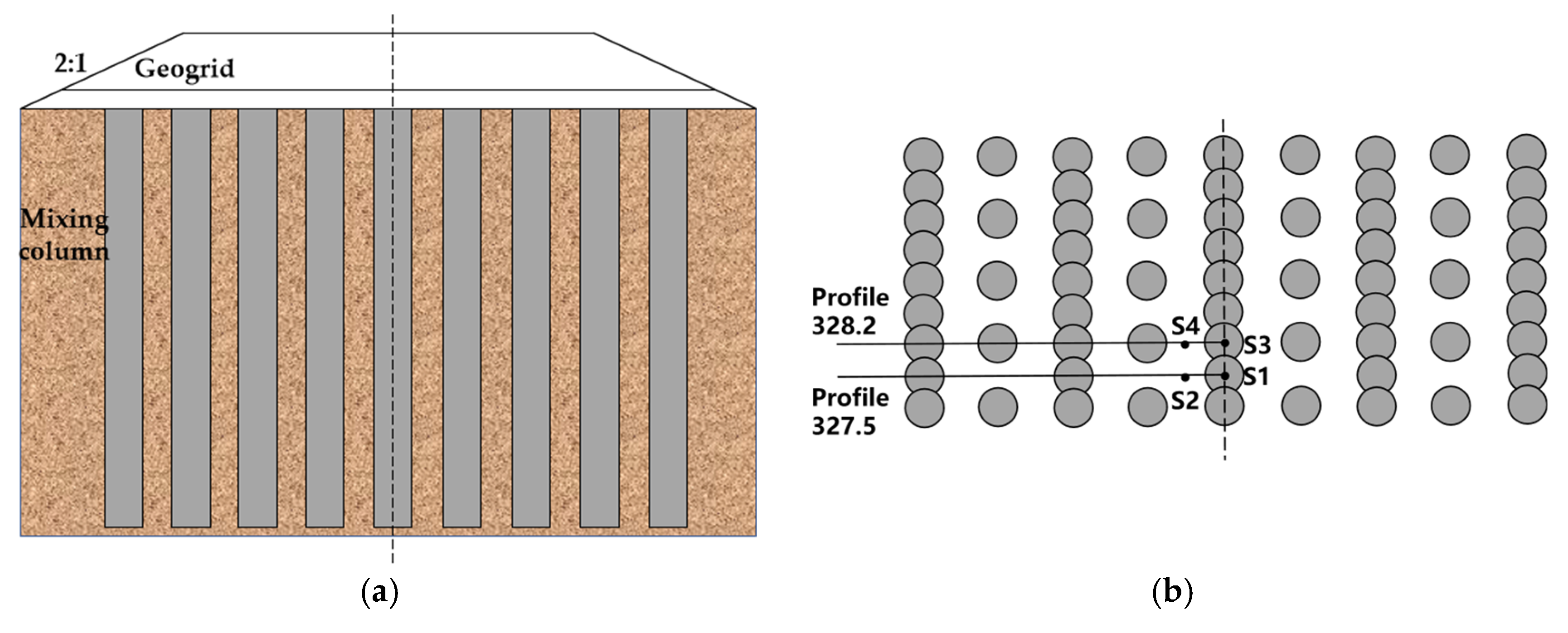
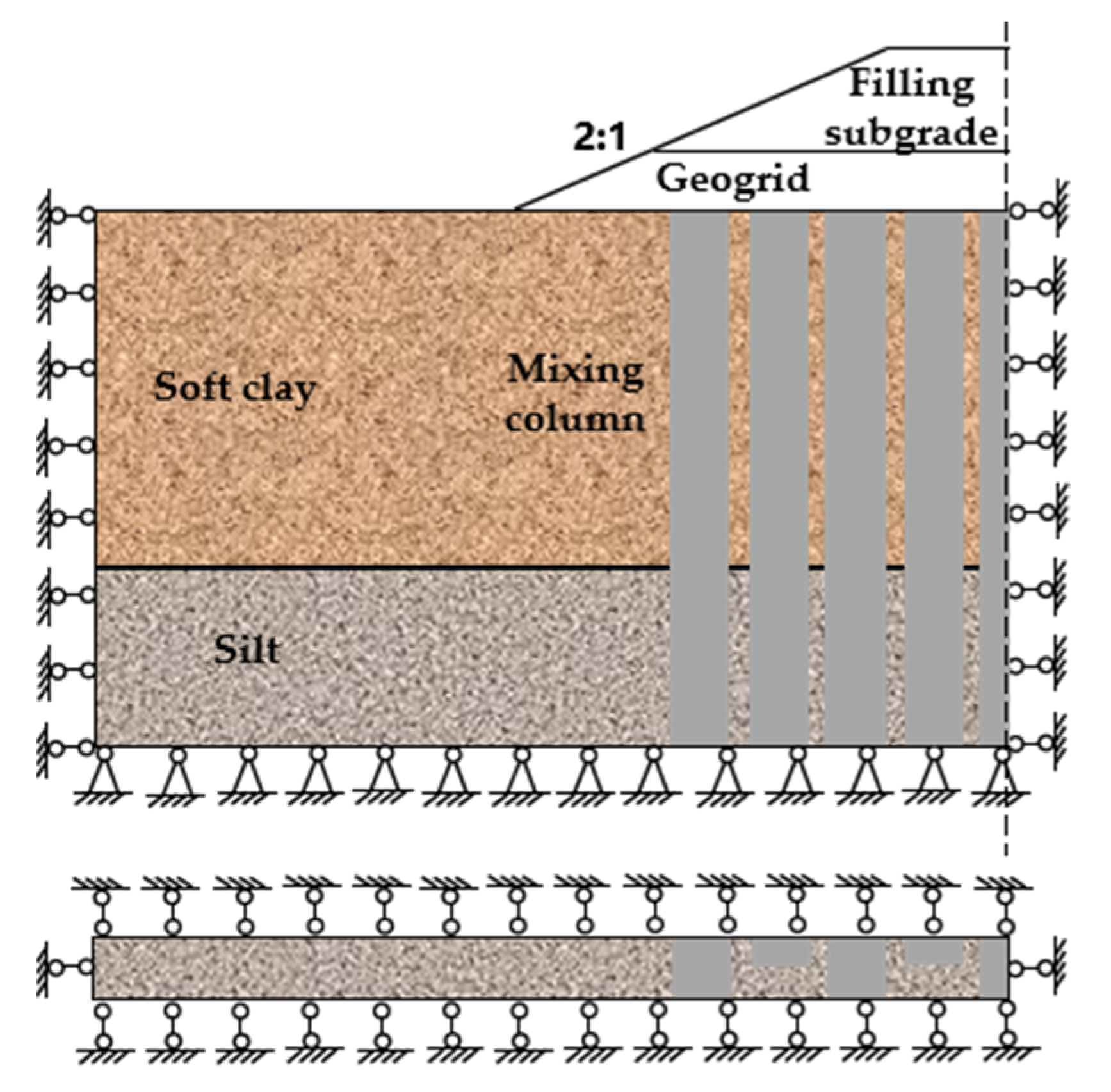
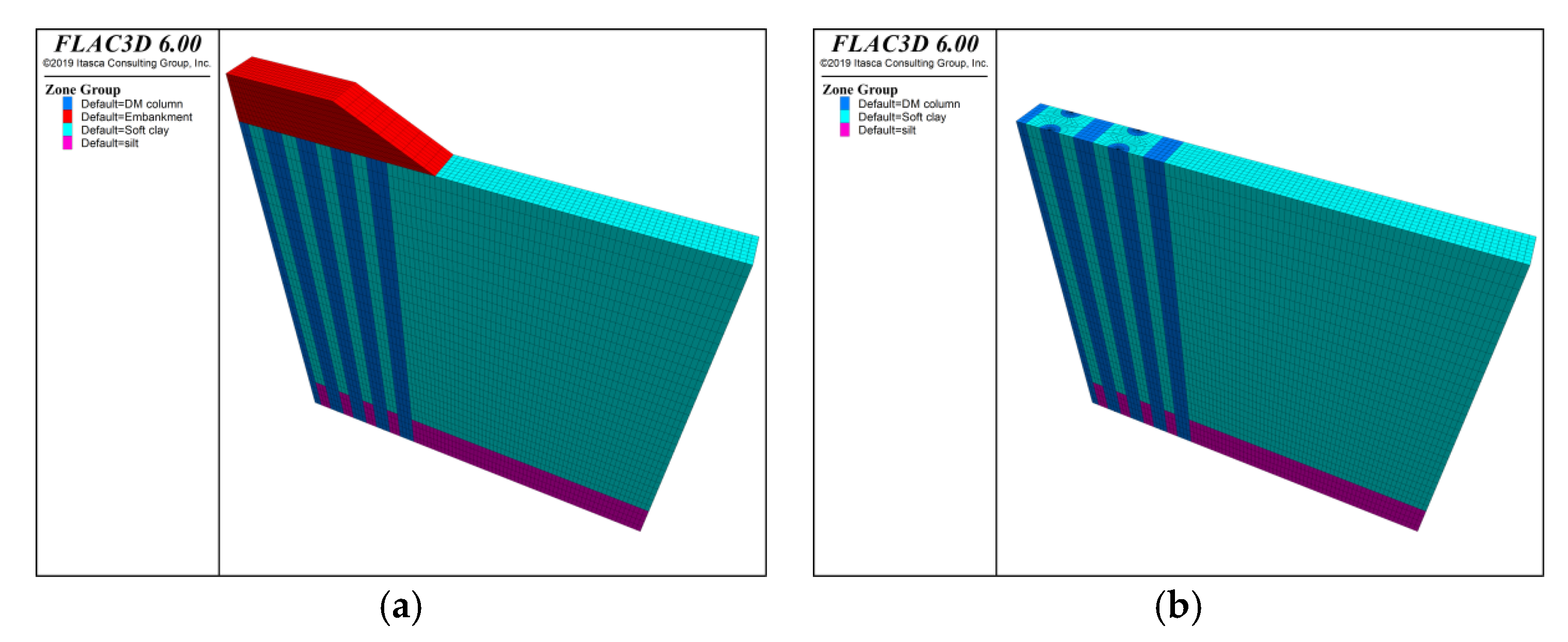
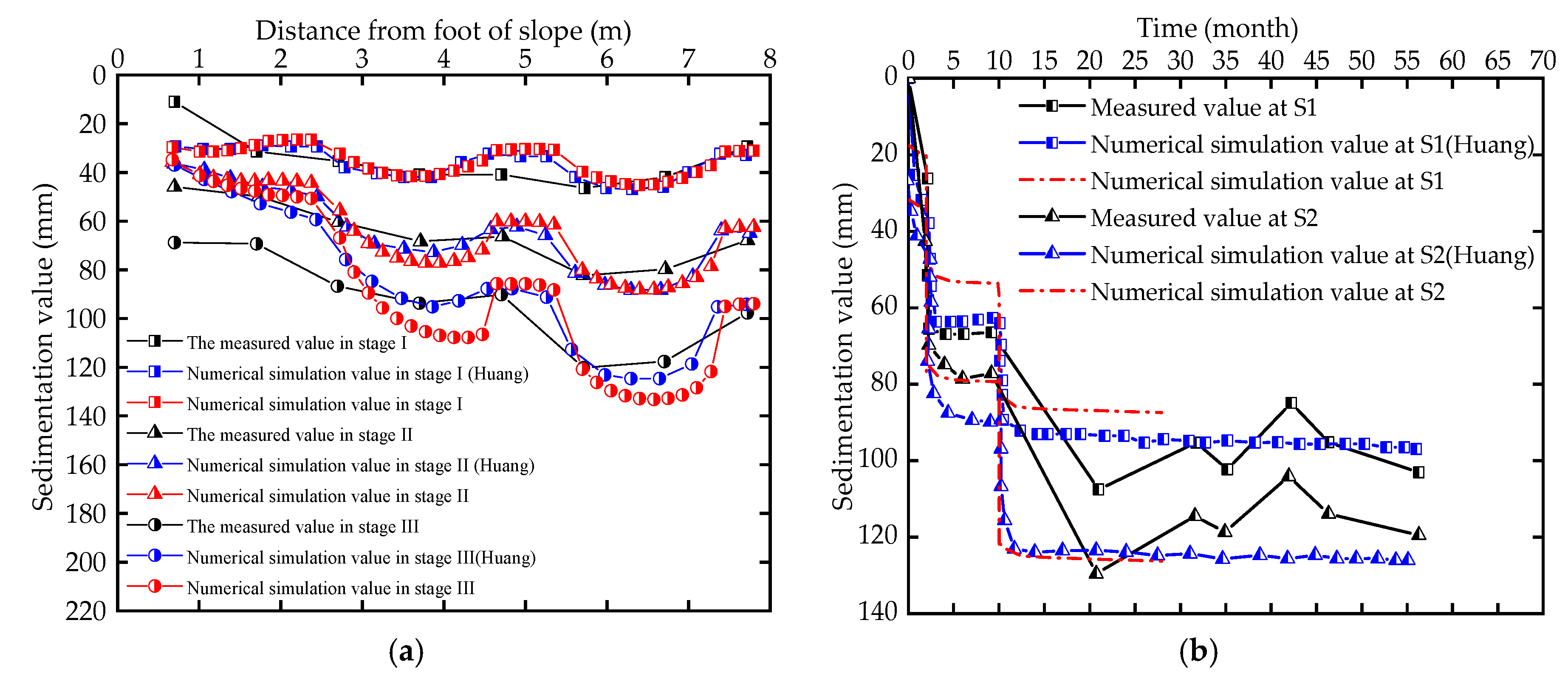
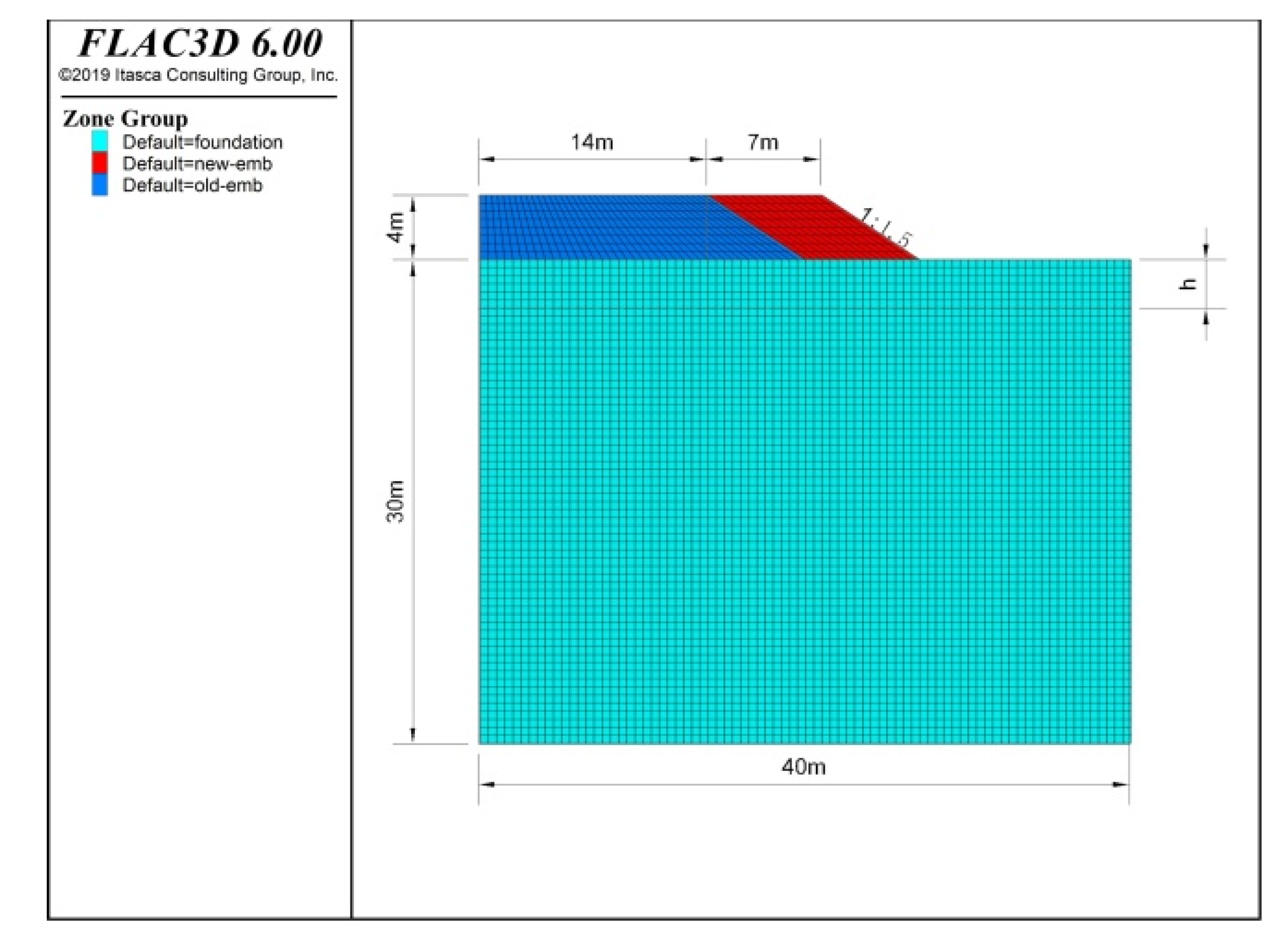

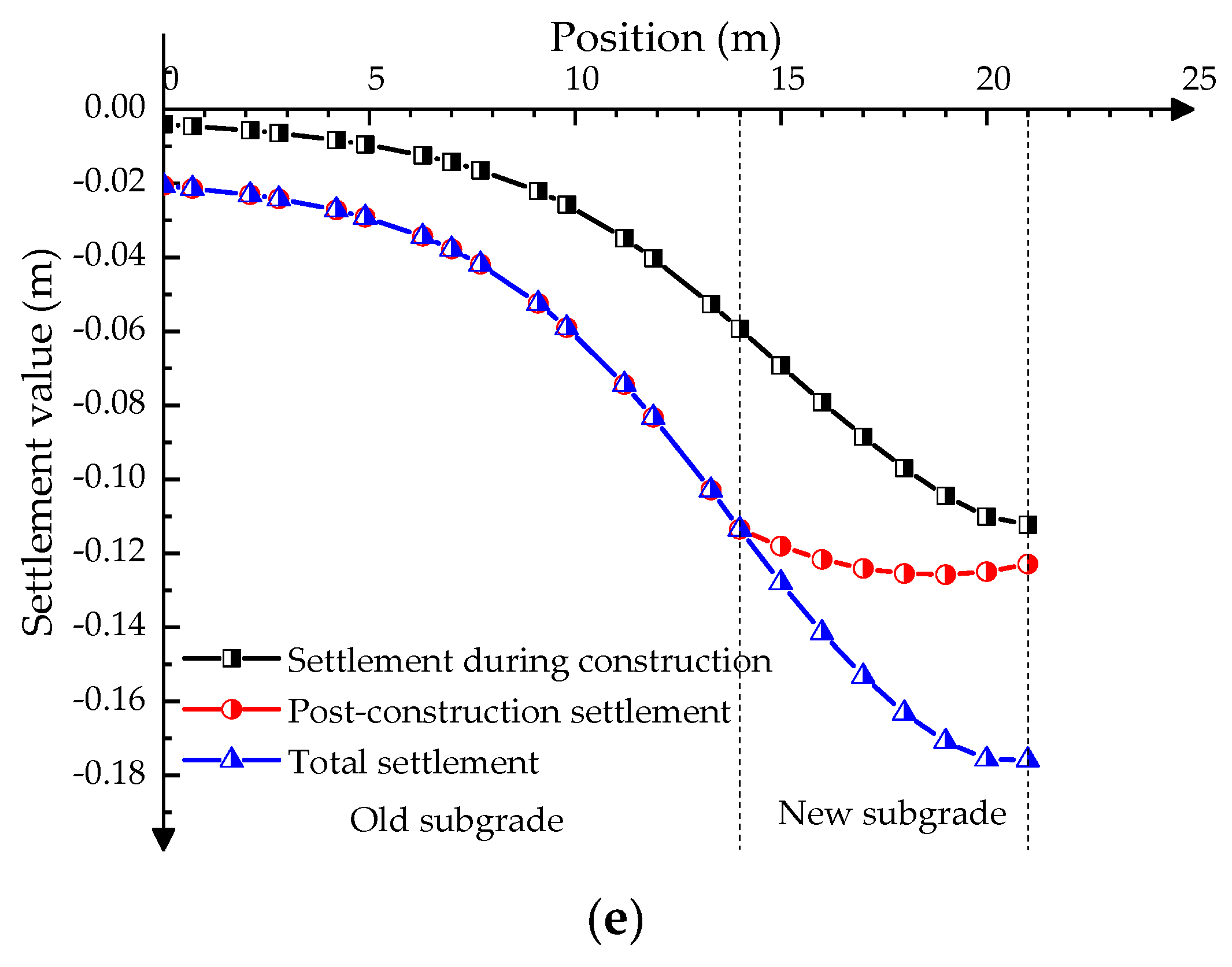
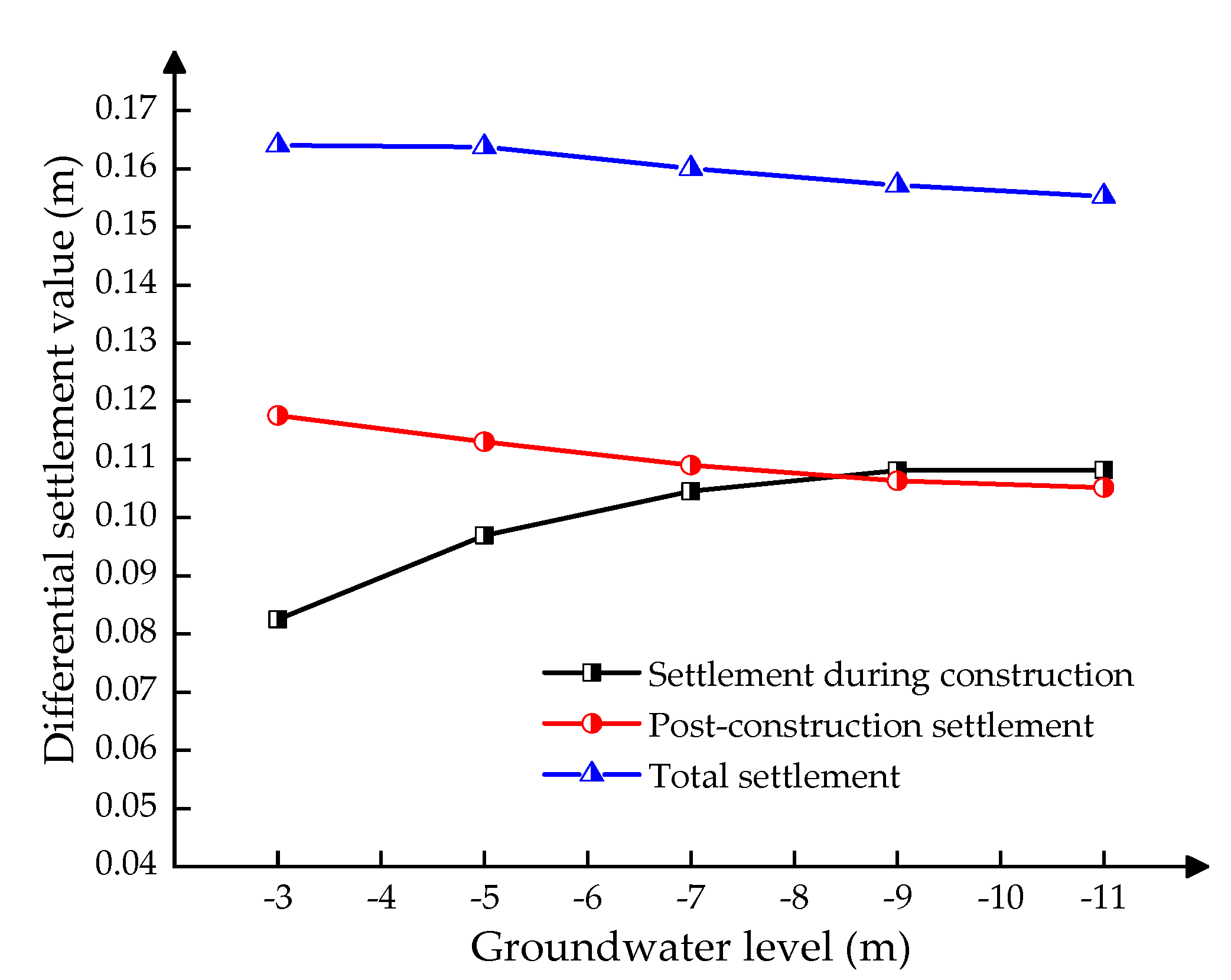
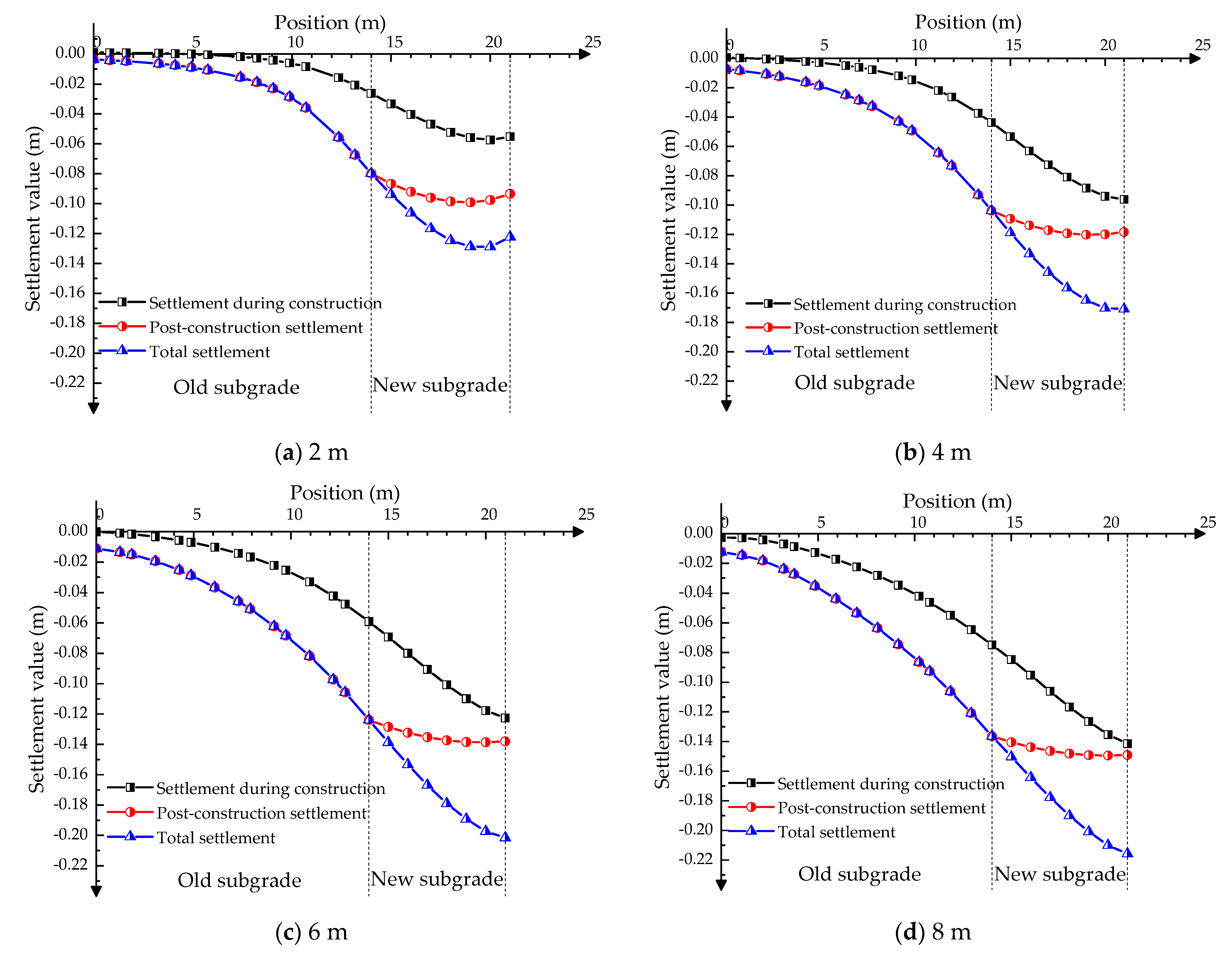
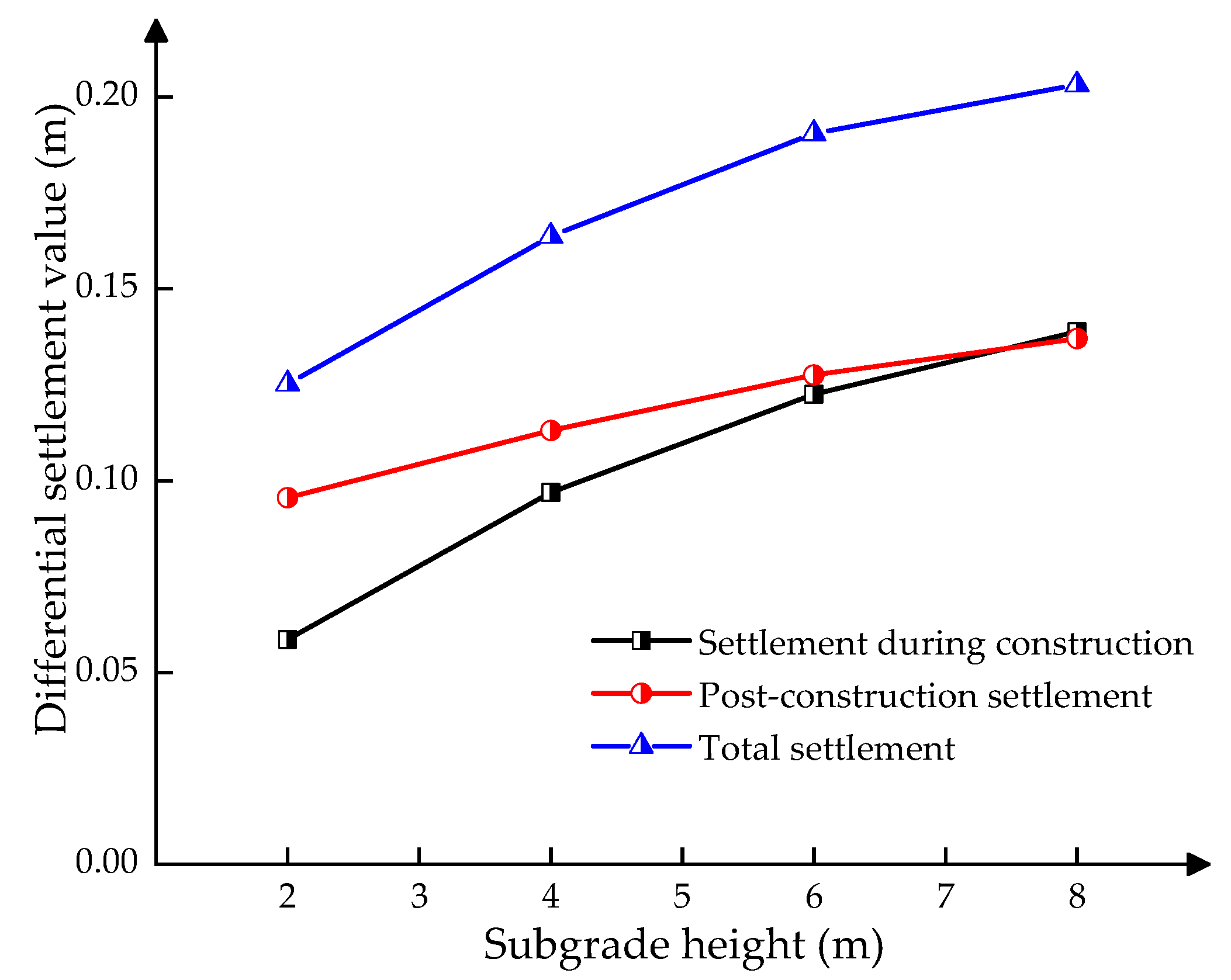
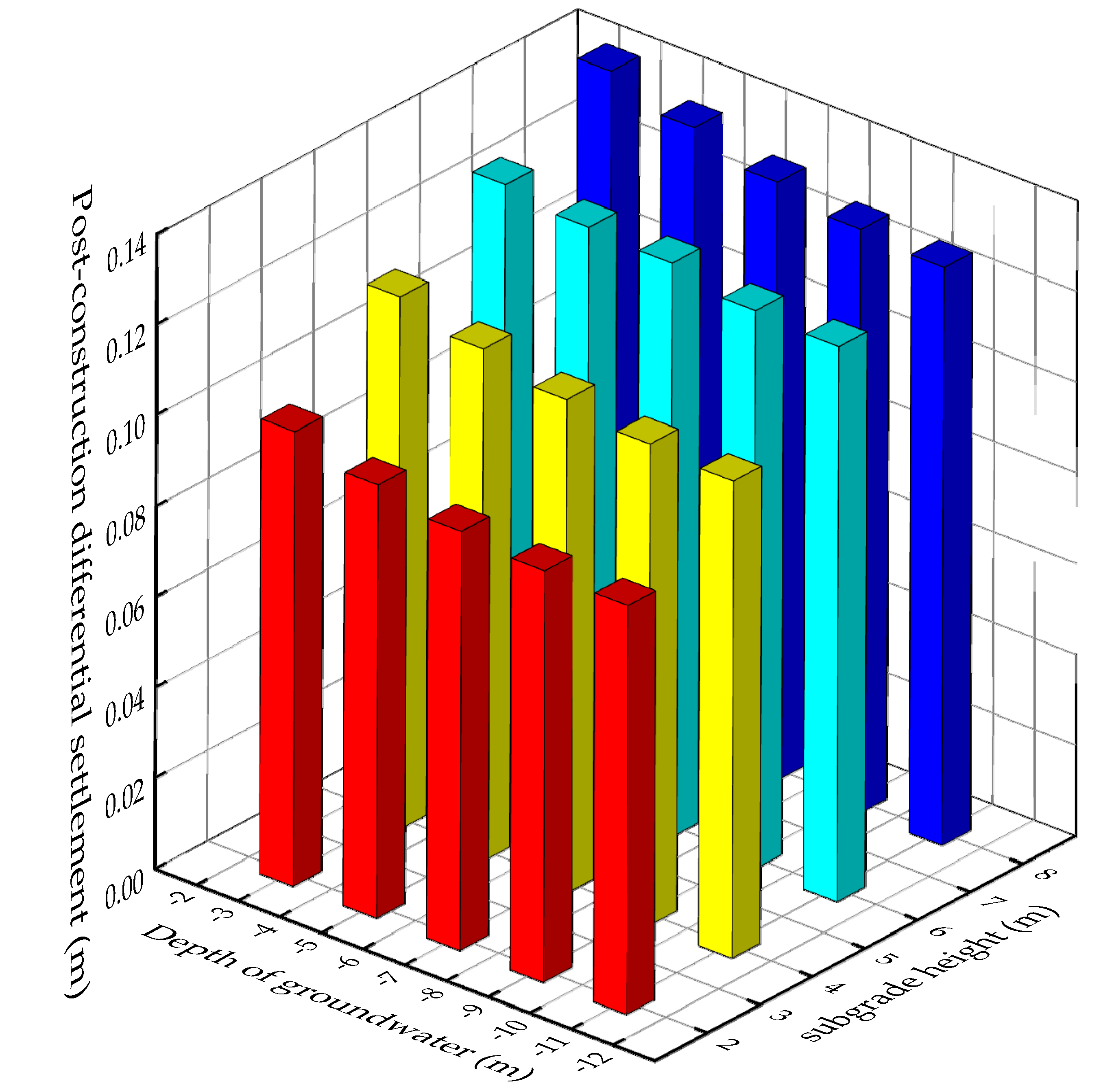
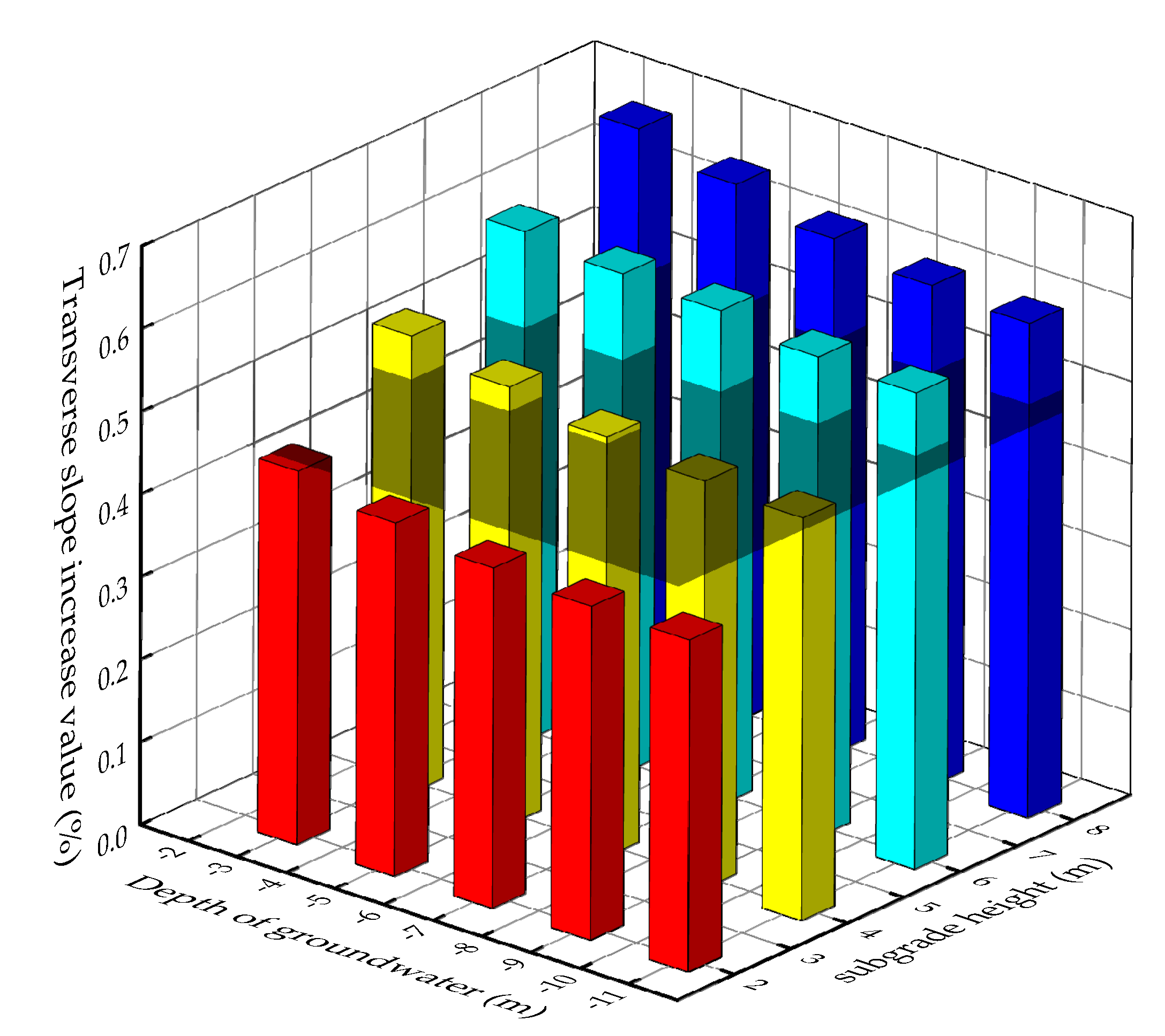
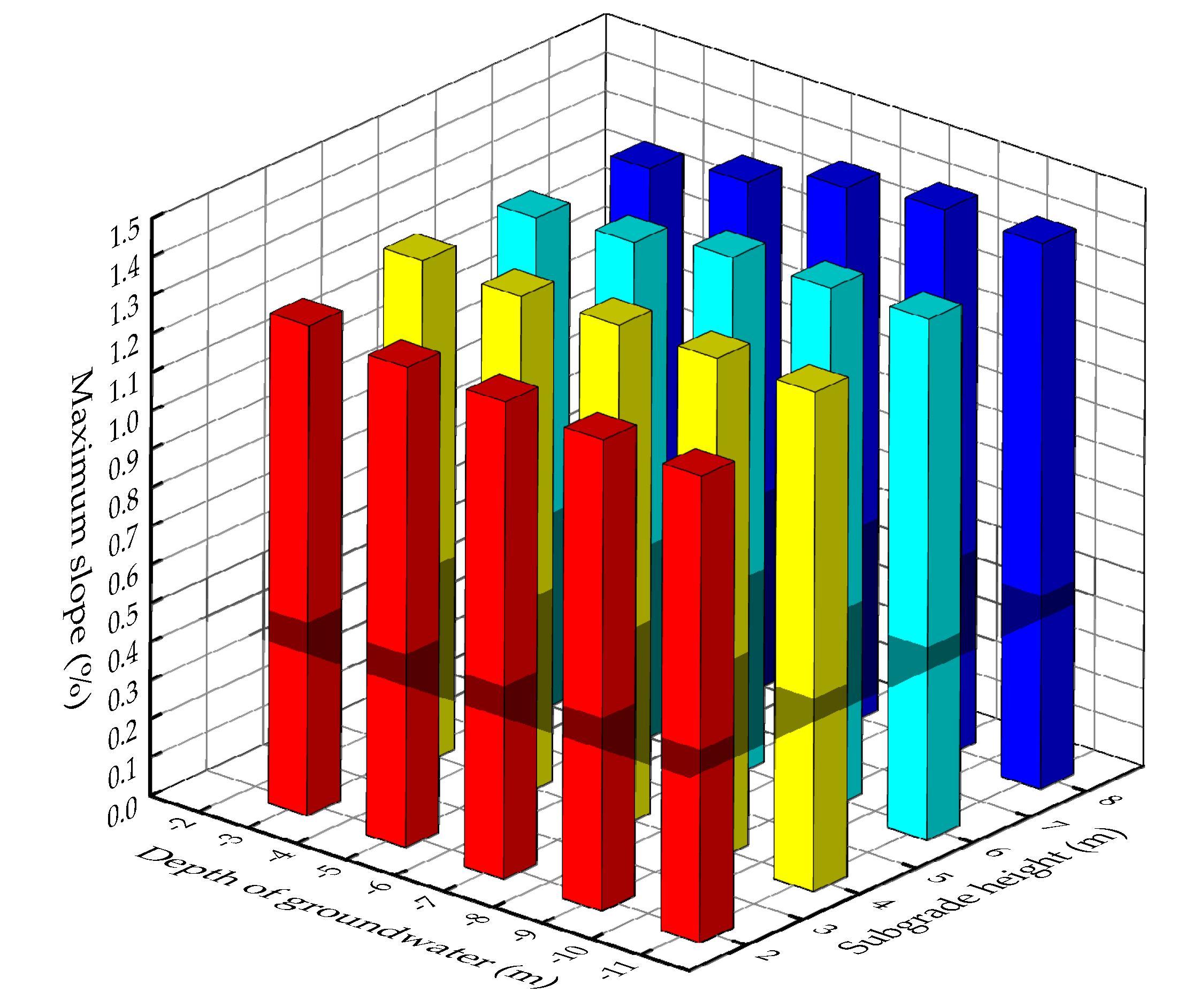
| Optimum Moisture Content (%) | Maximum Dry Density (g/cm3) | Liquid Limit (%) | Plastic Limit (%) | Plasticity Index |
|---|---|---|---|---|
| 12.0 | 1.91 | 31.19 | 19.98 | 11.21 |
| Parameters | Name | Value |
|---|---|---|
| normal consolidation line slope | 0.04934 | |
| unloading/reloading line slope | 0.00474 | |
| preconsolidation pressure | 1000 Pa | |
| v0 | specific volume | 1.85 |
| Poisson ratio | 0.35 | |
| Bmax | bulk modulus | 5 × 109 Pa |
| density | 1623 kg/m3 | |
| critical state line slope | 1.24 |
| Position | ρ (kg/m3) | E (MPa) | φ (°) | c (kPa) | |
|---|---|---|---|---|---|
| Old subgrade | 1950 | 37.1 | 0.30 | 27.0 | 47.0 |
| New subgrade | 1950 | 29.7 | 0.30 | 25.0 | 45.0 |
| Groundwater Level (m) | Differential Settlement during Construction (m) | Post-Construction Differential Settlement (m) | Total Differential Settlement (m) | Percentage of Post-Construction Differential Settlement (%) |
|---|---|---|---|---|
| −3 | 0.0825 | 0.1176 | 0.1640 | 71.67 |
| −5 | 0.0969 | 0.1131 | 0.1637 | 69.06 |
| −7 | 0.1045 | 0.1090 | 0.1600 | 68.12 |
| −9 | 0.1081 | 0.1063 | 0.1572 | 67.65 |
| −11 | 0.1082 | 0.1052 | 0.1552 | 67.74 |
| Subgrade Height (m) | Differential Settlement during Construction (m) | Post-Construction Differential Settlement (m) | Total Differential Settlement (m) | Percentage of Post-Construction Differential Settlement (%) |
|---|---|---|---|---|
| 2 | 0.0586 | 0.0955 | 0.1252 | 76.28 |
| 4 | 0.0969 | 0.1131 | 0.1637 | 69.09 |
| 6 | 0.1225 | 0.1276 | 0.1905 | 66.98 |
| 8 | 0.1388 | 0.1370 | 0.2032 | 67.42 |
Disclaimer/Publisher’s Note: The statements, opinions and data contained in all publications are solely those of the individual author(s) and contributor(s) and not of MDPI and/or the editor(s). MDPI and/or the editor(s) disclaim responsibility for any injury to people or property resulting from any ideas, methods, instructions or products referred to in the content. |
© 2023 by the authors. Licensee MDPI, Basel, Switzerland. This article is an open access article distributed under the terms and conditions of the Creative Commons Attribution (CC BY) license (https://creativecommons.org/licenses/by/4.0/).
Share and Cite
Lin, Q.; Zhang, Y.; Yang, C.; Wang, X.; Lei, T.; Ju, C.; Yao, Z.; Yao, K. Evaluation of Differential Settlement of Subgrade for Highway-Widening Projects. Sustainability 2023, 15, 2950. https://doi.org/10.3390/su15042950
Lin Q, Zhang Y, Yang C, Wang X, Lei T, Ju C, Yao Z, Yao K. Evaluation of Differential Settlement of Subgrade for Highway-Widening Projects. Sustainability. 2023; 15(4):2950. https://doi.org/10.3390/su15042950
Chicago/Turabian StyleLin, Qiqi, Yuhe Zhang, Chenjun Yang, Xiaohua Wang, Tao Lei, Chengwei Ju, Zhanyong Yao, and Kai Yao. 2023. "Evaluation of Differential Settlement of Subgrade for Highway-Widening Projects" Sustainability 15, no. 4: 2950. https://doi.org/10.3390/su15042950
APA StyleLin, Q., Zhang, Y., Yang, C., Wang, X., Lei, T., Ju, C., Yao, Z., & Yao, K. (2023). Evaluation of Differential Settlement of Subgrade for Highway-Widening Projects. Sustainability, 15(4), 2950. https://doi.org/10.3390/su15042950





